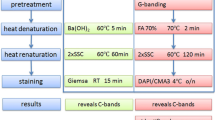Abstract
The similarities and differences between the banding patterns obtained in human chromosomes with the Quinacrine fluorescence and the Acetic-Saline-Giemsa (ASG) techniques are described. The use of these techniques to identify each chromosome pair in the human karyotype is discussed, as also is the use of the methods to identify aberrant chromosomes and to map points of exchange in translocations and inversions. A number of examples are used to illustrate the resolution permitted by these new methods. Seven polymorphic regions on normal chromosomes are described, which include four identified by fluorescence on chromosomes 3,4, 13, and 22. The secondary constrictions on chromosomes 1, 9, and 16, which had previously been observed in conventionally stained preparations from favourable material, are particularly clear in all cells treated with the Giemsa techniques. The new methods make it possible to detect small differences in size between the heterochromatic blocks at these regions in homologous chromosomes. The benefit to human genetics of studying the familial segregation of both structurally rearranged and normal, but polymorphic chromosomes, where the chromosomes or parts of chromosomes can be unambiguously identified is stressed.
Similar content being viewed by others
References
Arrighi, F. E., Hsu, T. C.: Localization of heterochromatin in human chromosomes. Cytogenetics 10, 81–86 (1971).
Barlow, P., Vosa, C. G.: The Y chromosome in human spermatozoa. Nature (Lend.) 226, 961–962 (1970).
Caspersson, T., Gahrton, G., Lindsten, J., Zech, L.: Identification of the Philadelphia chromosome as a number 22 by quinacrine mustard fluorescence analysis. Exp. Cell Res. 63, 238–240 (1970a).
—, Lomakka, G., Zech, L.: The 24 fluorescence patterns of the human metaphase chromosomes-distinguishing characters and variability. Hereditas (Lund) 67, 89–102 (1971a).
—, Zech, L., Harris, H., Wiener, F., Klein, G.: Chromosomes of mouse A9/human hybrid cells analysed using quinacrine mustard. Exp. Cell Res. 65, 475–478 (1971b).
—, Johansson, C., Modest, E. J.: Identification of human chromosomes by DNA-binding fluorescent agents. Chromosoma (Berl.) 30, 215–227 (1970b).
—, Modest, E. J., Foley, G. E., Wagh, U., Simonsson, E.: DNA-binding fluorochromes for the study of the organization of the metaphase nucleus. Exp. Cell Res. 58, 141–152 (1969).
Corneo, G., Ginelli, E., Polli, E.: Isolation of the complementary strands of a human satellite DNA. J. molec. Biol. 33, 331–335 (1968).
—: Repeated sequences in human DNA. J. molec. Biol. 48, 319–327 (1970).
Denver Conference, 1960: A proposed standard system of nomenclature of human mitotic chromosomes. Ann. hum. Genet. 24, 319–324 (1960).
Ganner, E., Evans, H. J.: The relationship between patterns of DNA replication and of quinacrine fluorescence in the human chromosome complement. Chromosoma (Berl.) 35, 326–341 (1971).
Hungerford, D. A.: Leucocytes cultured from small inocula of whole blood and the preparation of metaphase chromosomes by treatment with hypotonic KCl. Stain Technol. 40, 333–338 (1965).
Jones, K. W., Corneo, G.: Location of satellite and homogeneous DNA sequences on human chromosomes. Nature (Lond.), New Biology 233, 268–271 (1971).
O'Riordan, M. L., Robinson, J. A., Buckton, K. E., Evans, H. J.: Distinguishing between the chromosomes involved in Down's syndrome (Trisomy 21) and chronic myeloid leukaemia (Ph1) by fluorescence. Nature (Lond.) 230, 167–168 (1971).
Pardue, M. L., Gall, J. G.: Chromosomal localisation of mouse satellite DNA. Science 168, 1356–1358 (1970).
Pearson, P. L., Bobrow, M.: Fluorescent staining of the Y chromosome in meiotic stages of the human male. J. Reprod. Fertil. 22, 177–179 (1970).
Steel, M.: Non-identity of apparently similar chromosome aberrations in human lymphoblastoid cell lines. Nature (Lond.) 233, 555–556 (1971).
Sumner, A. T., Evans, H. J., Buckland, R.: New technique for distinguishing between human chromosomes. Nature (Lond.) New Biology 232, 31–32 (1971).
—, Robinson, J. A., Evans, H. J.: Distinguishing between X, Y, and YY-bearing human spermatozoa by fluorescence and DNA content. Nature (Lond.) New Biology 229, 231–233 (1971).
Author information
Authors and Affiliations
Rights and permissions
About this article
Cite this article
Evans, H.J., Buckton, K.E. & Sumner, A.T. Cytological mapping of human chromosomes: results obtained with Quinacrine fluorescence and the Acetic-Saline-Giemsa techniques. Chromosoma 35, 310–325 (1971). https://doi.org/10.1007/BF00326281
Received:
Accepted:
Issue Date:
DOI: https://doi.org/10.1007/BF00326281



